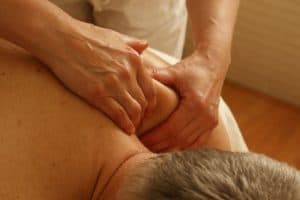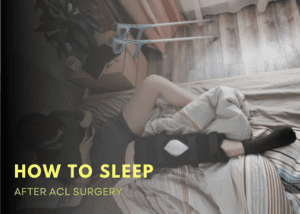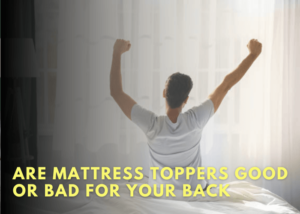We hope you love the product we recommend! Just so you know, at no extra cost to you, we may get a small commission for purchases made through links in this post. Your support is appreciated. Enjoy the read!
The piercing clang of the alarm clock jolts you awake and you feel it.
A stiff, uncomfortable crick in your neck.
Also known as a creak in the neck, crook in the neck or a neck kink, this painful problem can strike at any time.
It’s difficult – or downright agonizing – to get out of bed or even turn your head.
Your first thought is “How do I get rid of this crick in my neck?!”
What is a Crick in the Neck?
The catch-all term applies to a variety of ailments that cause pain and limit mobility.
These sensations can be triggered by a pinched nerve, an injury or a chronic condition.
Most often, neck kinks are due to muscle or soft tissue strain.
This means your muscle is “overstretched” and might need some extra rest or treatment to get back to normal.
What Causes a Crink in the Neck?
 All joints require lubrication.
All joints require lubrication.
Imagine a car, for example, you regularly check the oil to ensure a smooth ride.
Well, it’s the same for your body to function properly. Rather than oil, our bodies require synovial fluid to maintain healthy joint motion.
Deeper in the joint cavity lies part of the synovial membrane called the meniscus. The meniscus can get entrapped between the joint surfaces due to quick or sudden movements.
According to Dr. Kody,
“Those kinks in the neck are known as meniscoid entrapment.
It is basically when the fluid disk in the cervical spine gets caught due to a prolonged improper position.
This can then lead to a neurological guarding cascade where the muscles will tighten up and often cause a sharp sensation.
The body thinks the nerve will be damaged, so it protects you.
Anecdotally, I usually see it accompanied by a rib dysfunction component that leads to the same guarding pattern as the meniscoid entrapment.”
There are many different factors that can contribute to your neck crick, so remember to…
1. Check Your Bedroom
This is usually what we associate neck cricks with – sleeping.
Is your bed a cozy haven with tons of pillows and a soft mattress?
It sounds comfy, but this set-up may lead to some strange sleep positions and insufficient support for your neck.
Experts at Harvard Medical School say sleeping on your back or your side is the best for neck health and comfort.
This is what Dr. Patti had to say about this:
“It’s all about the curves!
Your neck curve needs to be maintained while sleeping.
To do this, use a feather-like pillow and scrunch it into the space at side of neck (side sleeping) or back of neck (back sleeping).
Sorry no stomach sleeping!”
Don’t worry, stomach sleepers! It’s never too late to train yourself to sleep on your back.
2. Check the Office
At work or school, hunching over a computer screen or mobile phone for hours can also cause neck cricks to develop.
So, remember to set your workstation up as ergonomically as possible, and set a timer to remind yourself to get up and stretch your legs.
Here’s an actionable tip from Certified Massage Therapist, Ivan:
“Throw your smart phone away and get a flip phone instead.
Its low-tech functionalities mean you won’t want to play with it so often, which will reduce your cell phone screen time AKA neck strain!”
Or you can just limit your screen time, but we all know how difficult that is…
Did we say how important it is to take breaks often?
Dr. Theo agrees and suggests this simple yet effective exercise of pointing your chin up to the ceiling.
“When sitting in front of a desk at work, it’s very important to put your neck in extension every 20-30 min for about 2 min while closing your eyes and taking deep breaths.
This will prevent having reverse cervical curve, turn off stress hormones in the body, relax tight muscles accumulated from sitting, and improve oxygen and blood flow to the eyes to prevent eye strains and headaches.”
3. Check for Recent Injury
Did you recently experience an athletic injury? Or perhaps you were in a fender bender and suffered whiplash?
You might feel a crick in your neck after a trauma, even a day or two later.
If that’s the case, then you should seek professional help. Be it a physiotherapist or registered massage therapist or Chiropractor.
Better yet, go see them all – just make sure it’s covered under your work benefits first.
How to Recover from Neck Crick
Luckily, there are plenty of options to consider when deciding how to treat your neck kink and regain your comfort.
Once again, Dr. Kody to the rescue:
“We treat these by desensitizing the nerves in the area by a collection of techniques.
This includes some cupping, soft tissue massage, joint manipulation, and patient education.“
1. Beginner Stretches For the Neck
Stretching is a simple, no-cost technique to gently ease the pain in your stiff neck.
Dr. Patti at it again with a suggestion:
“Restore your neck curve and reduce muscle tension by simply pulling your head back with eyes level (like a chicken).
And, if you make/see a double chin, it is the correct action :)”
Elaborating further, Physiotherapist Marcel says:
“1) Chin tuck exercises
Literally tuck your chin and try to make your chin touch your chest. Hold for 10 seconds.
Do 3 sets of 10 reps twice a day until you get more movement in that area.
2) If you need more help, see a physiotherapist or chiropractor, so they can do a gentle traction on your neck.
If you cannot see a professional and it’s an emergency, here’s a quick DIY you can do at home.”
2. Hot Shower to Relax Muscles
Hot compresses and cold packs can offer temporary relief and some products even do double duty.
Some doctors suggest using an ice pack for the first 2-3 days and then switching to heat.
Don’t have an ice pack?
Don’t bother spending money on buying one. Dig that bag of frozen peas from the back of your freezer and wrap it in a hand towel!
What does Dr. Giselle & Dr. Crysta say about this?
“If you find that the muscles in your neck are really tight by the end of the day, it is good to get them to relax before you go to bed to prevent that sore neck in the morning.
One method is a nice, warm Epsom salt bath.
Fill the bathtub with warm water, add 2 cups of Epsom salts and soak for at least 10-15 minutes.
The salts help us relax, improve sleep and concentration and help with proper functions of our nerves and muscles.”
“Hop in the shower!
While the hot water is heating your neck muscles, slowly turn your head until you first experience discomfort, and then look down to the armpit of the side you just turned to.
Hold for 1 minute. Repeat on the opposite side”
3. Does Cupping Work? Try It!
We’ve all heard of it.
Or, at least we have seen it…on a lot of Olympic athletes’ backs.
ahem *Michael Phelps* ahem
Most of us have seen those disk-shaped patterns adorning the backs of those who have tried it, but what actually is it?
Cupping is an ancient form of alternative Chinese medicine.
The process of cupping involves placing special cups on certain points of a person’s skin and creating a suction.
The build-up of pressure and suction sensation can be an effective way of relieving chronic pain, relaxing muscles and also increasing steady blood flow.
Here is a short clip on cupping to help you get to grips with this modern adaption of an effective ancient method.
4. Is Cracking Your Neck Bad? See a Chiro!
Joint manipulation is also a commonly-used practice amongst sufferers of meniscoid entrapment.
A licensed chiropractor can provide “hands-on spinal manipulation” to ease the pain of your stiff neck and get your skeleton back into alignment.

It’s often associated with the “pop” or “click” sound of a joint popping back into place.
This method of applied force to a targeted area is a proven way of unlocking joints, relieving musculoskeletal pain and improving range of joint motion.
With that said, it’s probably not a great idea to attempt this on your own.
5. Stiff Neck Massage
Soft tissue massage is another popular method of pain relief.
Less intrusive than deep tissue massage, it’s an effective way of reducing symptoms.

Massage therapists use pressure and kneading techniques to target muscles, ligaments, tendons and other connective tissues.
The result is relaxed tight muscles and improved body mechanics.
Using chiropractic and massage treatment together can offer especially soothing benefits. You can check with your health insurance provider to see whether one or both services are covered.
6. Don’t Sleep Wrong – Avoid Neck Pain
Back and side sleeping makes it easier to support your head with pillows and maintain straight alignment through your whole spine.
These positions are great for people currently suffering from a crick in the neck and those who want to avoid muscle strain.

The pillows you use makes a difference too.
Pillows made of foam or stuffed with feathers can mold to the shape of your head and neck rather than pushing it out of adjustment.
I transitioned to using one pillow after I realized that two set my neck at an awkward angle.
Even Dr. Giselle says so!
“If you’re consistently waking up with a crick in the neck, it may be time to change your pillow.
Many people are sleeping with pillows that are either too high for them or too low for them which affects the alignment of the neck.
When choosing a pillow you want to make sure your head is in line with the rest of the spine.
If you’re a side sleeper, you don’t want your head tilted up or tilted down. If you’re a back sleeper, you don’t want your head pushed forward or falling back.”
To really drive it home, Dr. Tony has a few words to say too!
“Sleep in a “neutral” position.
Imagine that you are standing and looking straight ahead, now turn yourself on your side OR back.
Your head and neck should be supported, without moving from neutral, by your pillow.
NEVER sleep on your belly!
Would you ever turn your head to end of joint motion (left or right) and hold it for hours while awake?
If you wake with a “crick in your neck”, it could be the symptoms from a greater underlying structural deficiency or a biomechanics dysfunction.
Make sure that you have a someone who understands the nuances of spine biomechanics on your healthcare team.”
6 Tips to Prevent Neck Kinks
Your delicate neck has the important job of supporting a 10-pound watermelon (I mean, your head) every day!
Implementing some healthy habits can lower your risk of getting a crick in your neck.
These suggestions should help keep your neck comfortable and aligned.
- Develop a stretching routine you do at the same time every day.
This might be during your morning shower or right before you hop into bed at night.
- Set a timer to take breaks away from your computer and phone.
I like to leave my desk and go for a walk outside – no electronics allowed. Even standing up to chat with coworkers count
- Sleep in a position that fully supports the correct alignment of your spine and neck.
This means to sleep on your side properly or on your back with your pillow at the right height.
Stop reaching into the back seat when grabbing objects.
When moving objects overhead, use two hands and don’t use a ballistic motion as it can irritate the rib areas.
There is no perfect pillow, so the rule of thumb is to keep oneself in a neutral position.
Eg. side sleepers need a pillow or collection of pillows to fill the gap between the shoulder and neck so that the head is not tilted one way or another (this includes if someone puts their hand under their pillow when they sleep)
Can Neck Pain be a Sign of Something Serious?
It might be time to reach out to a trusted medical professional if you:
- Have been suffering for a few weeks or if the pain becomes increasingly severe.
- Are experiencing other symptoms, such as a tingling sensation, numbness, or a severe headache, might indicate a more serious condition.
- Are a bit older, as you may have a higher likelihood that their stiff neck is caused by an underlying disorder, such as Arthritis.
A physician can order tests to explore the cause of your neck kink. They might prescribe physical therapy or medication to bring you relief.

Information is Power
Here’s another tidbit of gold nugget from Dr. Kody:
“Pain science research shows that if patients understand their condition, its severity, and how to manage it, they are less anxious.
Therefore, providing a prognosis and more information will empower patients and decrease their pain levels.”
This just makes sense.
Patient education is recommended so that the person knows what exactly is happening, what caused it, how to prevent it and how to manage it effectively.
Knowledge is power.
We all fear the unknown, but once you know, you can take action to reduce that fear.
 So, it’s not just a simple neck pain after all!
So, it’s not just a simple neck pain after all!
After delving into the science behind your crick in the neck, you can see that there’s a lot more to it than meets the eye.
Straight from the horse’s mouth, education is key when it comes to dealing with any kind of condition.
Now that you understand the potential causes behind your pain, it’s time to test out some of the prevention techniques we covered above.
Small lifestyle changes can make a huge difference when it comes to healthcare so start taking a step in the right direction.
That’s a wrap!
Hopefully, this article was helpful in shedding light on how to get rid of a crick in your neck.
Put some of these suggestions into practice and let us know how it goes!
>> Learn more about mattress, here’s our lucid mattress review! <<
















